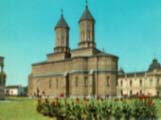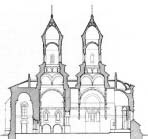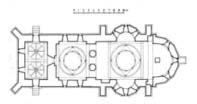THE "THREE HIERARCHS" CHURCH IN IAȘI
by AURELIAN TRIȘCU


| French Romanian | |
THE "THREE HIERARCHS" CHURCH IN IAȘIby AURELIAN TRIȘCU |
 |
Carved in stone on the southern facade of the "Three Hierarchs" church, the votive legend reads: "we raised this church in the name of the three saints: Vasile the Great, Gregory the Theologian and John Chrysostome and it was blessed in May, the sixth, 7147 (1639) by the Metropolitan Bishop Varlaam...". All of a sudden, the patrons of the church place the edifice in a world that once belonged to the Holy Fathers of the Church, defenders of the Nicene dogmas, haloed by knowledge and renowned for their ardour. If at that time, during the tormented 4th century AD, the three theologians struggled to save the unity of the church, twelve and a half centuries later the church builders bearing their names succeeded in merging the influence of different worlds into one monument, steeped in the local tradition. The ecclesiastical space thus created counts among the most illustrious of its kind in Romanian art, in the history of the people, of the country and in the Orthodox church. It stands as a landmark of a significant historical time embracing prodigious trends and it is representative for the spirituality of a resourceful community, unique in its artistic achievements.
The builder of this unmatched monument is the pious Prince of Moldavia Vasile Lupu, one of the most distinguished personalities of Romanian History, well-known defender of the Orthodox Church. During the first years of his reign, when the Constantinople Patriarch was in a critical condition - crippled by debts, dominated by intrigues and hit by disorder - Vasile Lupu interfered and tried to put things right. At the same time, later he would pay the debts of the Holy Grave and those of the Athos Mountain monasteries and make many donations as the initiator of some Orthodox Christian religious and charitable works in Poland, Bulgaria and Greece.
Remarkable testimony of the Prince's greatness, the "Three Hierarchs" church stands in the heart of Iași, surrounded from the start by Saint Nicholas, Saint Sava, Golia and Barnovski churches, followed successively by other religious and secular monuments, attracted - we could say - by the traditional centre, by the place ennobled by history.
Impressive, it seems to be made to "thunderstrike" the souls of the contemporaries, as it is an answer to the desire for splendour of its builder about who Nicolae Iorga used to say that 'from the second day of his reign he renamed himself Vasile and penetrated the Byzantine dream'. And, indeed, the "Three Hierarchs" church in Iași reveals the craving to belong to this astonishing Byzantine world, combining traditional patterns and effects with precious materials and rich ornament.
As also G. Balș reports, the monument observes to a great extent the sixteenth century Moldavian church layout - a triconch plan, influenced by the Galata church, but having an extra turret above the narthex. The vault, observing the ingenious Moldavian vault system, comprises two overlapped rows of four and eight arches that added to the upper pendentives shorten the diameter of the bell turret. Outside, the facade decorative effects remind one of the Dragomirna monastery church (Moldavia 1606 - 1609) and the face divided by a moulding found in Wallachian monasteries.
| Church Plan |  |
 |
Transversal Section |
The influence of the Transylvanian Gothic is obvious when it comes to buttresses, the window stone reinforcing, the door design, the accolade-shaped mouldings and arches.
 'What is really special about the edifice and makes it one of the most original
creations of Moldavian art is the harmonious contrast between the well moulded and
proportional architectural forms, as well as the carved adornments covering like a lace all the
four facades, including the buttresses and the archvaults on each side and at the basis of the
bell turret.'
'What is really special about the edifice and makes it one of the most original
creations of Moldavian art is the harmonious contrast between the well moulded and
proportional architectural forms, as well as the carved adornments covering like a lace all the
four facades, including the buttresses and the archvaults on each side and at the basis of the
bell turret.'
The ornament is of a wide variety: fascicled archway deep niches like the Oriental patterns, colonnettes like those of Russian churches, Persian vases holding blossomed branches, geometric motifs found also in Georgia and Armenia, the face divided by a rope moulding framed by two Renaissance or Baroque marble strips. All this is arranged in a unity bathed in light. 'Further emphasised by a deep blue stressed by gilt, this decoration fully contributes to the fame that the "Three Hierarchs" church has known ever since it was built. Paul of Alep, archdeacon of Antioch, a fellow-traveller of Patriarch Macarie across the Romanian Principalities, in the sixteenth century, after surveying thoroughly the edifice expressed his entire enthusiasm in the book "Travels" written in Arabian and published in Bucharest in 1900 in a Romanian translation.
Around the church - where in July 1641 St. Paraschiva's relics had been placed, sent by the Constantinople Patriarch and Synod with gratitude for the generous actions and donations of Prince Vasile Lupu - a monastery was raised. Today only the Gothic hall has remained the old "Schola Basiliana", testimony of the rich cultural life of that epoch. The printing house was installed here while the printer used to be brought from Kiev due to Metropolitan Bishop Petre Movilă's help. The abbot and the headmaster of the newly opened school, monk Sofronie, led it. Here was issued the first printed work (in Greek) of Moldavia and the next year, the famous Book of Sermons (Cazania) of Metropolitan Bishop Varlaam.
Without ever being equalled, the main edifice of Vasile Lupu was used as source of inspiration for building and decorating the church of the architectural pile of Cetățuia monastery (1669 - 1672) in the very vicinity of Iași as well as Putna monastery church.
On the occasion of the restoration works due to Lecomte du Nouy between 1882 and 1890, the "Three Hierarchs" church had most of its original inner painting destroyed. Certain controversial interventions marked at the time a characteristic stage in the restoration process in Romania. The period knew public actions and debates, battles of wits between the intellectuals of the epoch and the authorities that finally led to the promotion of some correct principles regarding the protection and restoration of historical monuments.
In January 1993, the Iași workshop proceedings under the aegis of the Romanian National Commission for UNESCO, Iași townhall, the local council and the Metropolitan Church of Moldavia and Bucovina revealed the results of many professional studies regarding the state and needs of the building as well as the authorities' involvement in the preservation and singling out of the edifice.
Today, the "Three Hierarchs" church is over 350 years old. It represents a unique monument bearing the stamp of tradition. Its age that now blurs some of its once glorious decoration, at the same time gives it the sobriety of time. Its slender profile and the horizontal adornments give brilliance to the entire church. If, as Anton Dumitru mentions in his "Book of Admirable Encounters", Paideuma means in Greek 'the cultured one', but it also means 'a studying place', 'a place where things happen', then such a place is the "Three Hierarchs" church in Iași. And that is because it stands proof of the degree in which varied cultural influences can mix up and coexist provided they should find a perfect harmony, in a serene atmosphere, close to a benefic host.